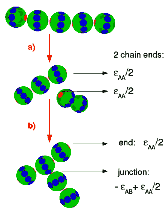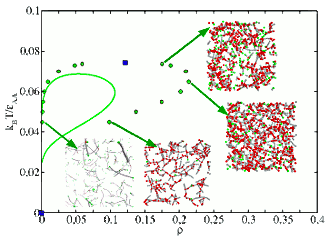News Notícias
CFTC: Publication in Physical Review Letters of the Lisbon model of patchy colloids
José Maria Tavares, Paulo Ivo Teixeira and Margarida Telo da Gama have co-authored a paper entitled “Reentrant Phase Diagram of Network Fluids”, which was published online by Physical Review Letters on 25 February. This is the result of a collaboration between the three CFTC researchers and the computer simulation group of Francesco Sciortino at the University of Rome “La Sapienza”.

Figure 1: Patchy particles with with 2A+9B sites.
This Letter studies a microscopic model proposed by the Lisbon team [1,2] for colloids with interaction sites on their surfaces (“patchy colloids”): these patches are of two types, A and B; on each particle there are two A sites and nine B sites (see figure 1). The particles may be linked together either via AA bonds, of energy -εAA, or via AB bonds, of energy -εAB. At low temperatures, formation of these bonds promotes the appearance of large clusters by chaining (AA bonds) and/or branching (AB bonds). It was shown that the competition between chaining and branching when εAB = 0.37εAA results in a peculiar type of phase behaviour (a reentrant or pinched phase diagram): contrary to what happens in simple fluids, it is possible to go from a two-phase to a one-phase region by cooling at constant volume (see figure 2).

Figure 2: The “pinched” phase diagram, with snapshots of the coexisting liquid and vapour phases.
This peculiar behaviour adds to a series of others that are predicted by theory and simulations and have been recently observed in experiments [3,4]: the formation of extremely low density (“empty”) liquids and of equlibrium gels.
The Lisbon model provides a reference system for a deep understanding of the competition between condensation and self-assembly into equilibrium-polymer chains, and may be relevant to systems such as strongly dipolar fluids.
References
[1] J. M. Tavares, P. I. C. Teixeira and M. M. Telo da Gama, Molecular Physics 107, 453-466 (2009).
[2] J. M. Tavares, P. I. C. Teixeira and M. m. Telo da Gama, Physical Review E 80, 021506 (2009).
[3] W. K. Kegel and H. N. W. Lekkerkerker, Nature Materials 10, 5-6 (2011).
[4] B. Ruzicka, E. Zaccarelli, L. Zulian, R. Angelini, M. Sztucki, A. Moussaid, T. Narayanan and F. Sciortino Nature Materials 10, 56-60 (2011).
